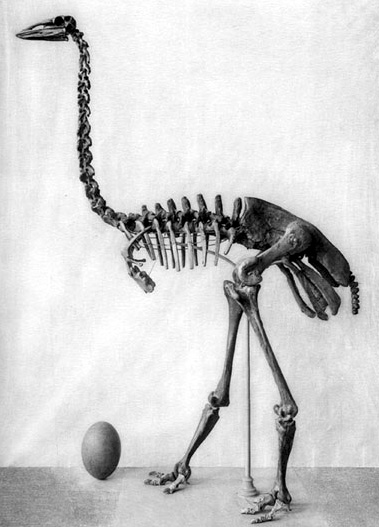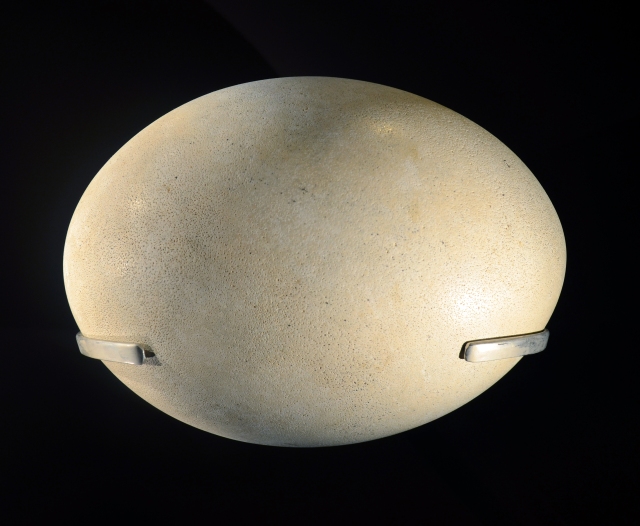“Vouronpatra: A large bird which haunts the Ampatres [marshy places] and lays eggs like the ostrich’s; so that the people of these places may not take it, it seeks the most lonely places.”
The beasts of the Pleistocene cause us so much wonder because they tend to be large, strange, and extinct. It is their palpable absence that defines how we think about the recent geological past. We can put them in a box along with dinosaurs, trilobites, and things from long, long ago. But there are anomalies which force us to reconsider how different the Pleistocene was, and ask whether the extinctions were really part of the natural order. There were populations of mammoth (Mammuthus primigenius) that survived up until only a few thousand years ago on Wrangel island and St. Paul island. The giant Irish elk (Megaloceros giganteus) eked out a living in the Ural mountains until the early Neolithic. The islands of the Mediterranean had endemic populations of hippo and elephant that squeaked into the Holocene. New Zealand had the giant moa that probably lasted until the 13th century AD. These examples tell of megafauna that almost survived into history.
Along with New Zealand, one of the last large pristine environments to be colonised by humans was the island of Madagascar. Settled from the east by Indonesian seafarers sometime around the first century AD, the pioneering Malagasy found an exotic eden, filled with giant lemurs and tortoises, pygmy hippos, and bizarre carnivores. They also found the largest bird ever known to have lived: the legendary elephant bird.
Two genera of elephant bird are known (Aepyornis and Mullerornis) and a handful of species. The largest (and probably latest surviving) was Aepyornis maximus, a giant at around 400kg. The elephant birds were members of the palaeognaths or ratites, a group of birds that includes the modern ostrich, emu, cassowary, rhea, and kiwi, as well as the recently extinct New Zealand moa. In life Aepyornis probably looked like a giant cassowary or emu, drab coloured for the most part. We don’t know for certain, because unlike the New Zealand moa, we’ve never found any feathers from an elephant bird to give evidence of the plumage.
However, there is one feature of the living Aepyornis that has left evidence in abundance: their record-breaking eggs. Bigger than any known dinosaur egg, the elephant bird eggs are probably the largest single-cell ever produced by nature. Larger than a rugby ball when whole, several examples are known that had been used as water containers by the Malagasy, even into the 19th century. Others have been found with the embryo still inside! [Read about the scanning and 3D printing of one example here]. On some Madagascan beaches the surface is almost entirely eggshell pieces, evidence perhaps of communal breeding amongst this extinct species. One quirk of biology amongst the ratites is that it is exclusively the males that brood the eggs- if Aepyornis did engage in group laying it would have been very much an old-boys club on the beach!
There are a few whole eggs in private collection, although Madagascan law now rightly forbids the export of such important items of natural history. The well-known naturalist Sir David Attenborough has a reconstructed egg, which was given to him (in broken pieces) while filming on the island. This egg was recently radiocarbon dated (by @tommyhigham) to the 7th-8th century AD.
Another recent scientific innovation involving elephant bird egg has been the isolation of ancient DNA from the shell itself. Given the rarity of elephant bird bones and the superfluity of eggshell, they offer the potential to really get a handle on the demography and biology of these lost giants.
The extinction of the elephant birds is slightly mysterious. Humans were certainly the root cause but there is surprisingly little evidence of the hunting and butchery of adult birds (there is one record of a human modified tibiotarsus). It is likely that a continuous and sustained collection of the giant eggs for consumption and cultural usage caused the extinction of the mighty Aepyornis and Mullerornis. But when did this occur? The latest radiocarbon dates on Aepyornis bone are from the first few centuries AD, the latest dates from eggshell are 10th or 11th century AD (with radiocarbon dating there is a range of uncertainty associated with each date). Of course, it is extremely unlikely that we will ever date the very last bird or egg that lived (and the discrepancy between dates from rare bone and abundant eggshell show this). Could the elephant bird have survived into the time when Europeans were present on Madagascar? The opening quote to this article is from the French Governor to Madagascar (in the 17th century it was a French colony), Etienne de Flacourt. In his book “Histoire de la grande isle Madagascar” he talks of native beasts such as the “Tretretretre”, which was a calf-sized animal with the face of a man and monkeylike feet (possibly a late-surviving giant lemur). His description of the “Vouronpatra” may be the only surviving evidence we have of the living Aepyornis. However, in the process of researching this post I came across one last possible record from another Frenchman, dating to 1667 (about ten years after Flacourt). Known only as Ruelle, the account from his journal is as follows:
“We met a terrible winged dragon … one day out hunting with a soldier who was accompanying me, we saw one at the foot of a tree, that rose into the air as soon as we saw it, with a horrible hissing and red eyes of fire. When he had risen to the height of two spears he began to fall upon us, so I fired a shot that caused him to fall at my feet, with a frightful writhing about. My soldier companion killed it with another shot. It was 15 feet long. The head and body big like a calf tapering from the wings to the tail. Its scales were black and yellow; the wings were three feet in diameter. It had two rough and scaly feet. The body, we skinned to present it to Mr. Marquis de Mondevergue”
It seems that even if the vouronpatra sought “the most lonely places”, they were not protection enough.
Written by Ross Barnett (@DeepFriedDNA)
Further Reading:
Burney, D. A., L. P. Burney, L. R. Godfrey, W. L. Jungers, S. M. Goodman, H. T. Wright, and A. J. Jull. “A Chronology for Late Prehistoric Madagascar.” J Hum Evol 47, no. 1-2 (Jul-Aug 2004): 25-63.[Abstract]
Burney, D. A., and Ramilisonina. “The Kilopilopitsofy, Kidoky, and Bokyboky: Accounts of Strange Animals from Belo-Sur-Mer, Madagascar, and the Megafaunal “Extinction Window”.” American Anthropologist 100, no. 4 (1999): 957-66.[Abstract]
de Flacourt, E. Histoire De La Grand Isle Madagascar. Paris: Alexandre Lesselin, 1658.[Full Book]
Goodman, S. M., W. L. Jungers, and V. Simeonovski. Extinct Madagascar. University of Chicago Press, 2014.[Book]
Hébert, Jean-Claude. “La Relation Du Voyage a Madagascar De Ruelle (1665-1668).” Études océan Indien 25-26 (1998): 9-94.[Abstract]
Heuvelmans, B. “22.The Tratratratra, Vorompatra, Etcetera.” Translated by Rupert Hart-Davis. In On the Track of Unknown Animals, 601, 1958.[Book]
Mitchell, K. J., B. Llamas, J. Soubrier, N. J. Rawlence, T. H. Worthy, J. Wood, M. S. Lee, and A. Cooper. “Ancient DNA Reveals Elephant Birds and Kiwi Are Sister Taxa and Clarifies Ratite Bird Evolution.” Science 344, no. 6186 (May 23 2014): 898-900.[Full Text]
Oskam, C. L., J. Haile, E. McLay, P. Rigby, M. E. Allentoft, M. E. Olsen, C. Bengtsson, et al. “Fossil Avian Eggshell Preserves Ancient DNA.” Proceedings Of The Royal Society B-Biological Sciences 277, no. 1690 (2010): 1991-2000.[Full Text]
Perez, V. R., L. R. Godfrey, M. Nowak-Kemp, D. A. Burney, J. Ratsimbazafy, and N. Vasey. “Evidence of Early Butchery of Giant Lemurs in Madagascar.” J Hum Evol 49, no. 6 (Dec 2005): 722-42.[Full Text]
Rawlence, N. J., J. R. Wood, K. N. Armstrong, and A. Cooper. “DNA Content and Distribution in Ancient Feathers and Potential to Reconstruct the Plumage of Extinct Avian Taxa.” Proceedings of the Royal Society of London: Series B (2009).[Full Text]




Pingback: When is an aardvark not an aardvark? When it’s from Madgascar! | TwilightBeasts
Like most old cryptozoological sources the 1667 account seems ambiguous and needs selective lenses to see anything optimistic about it. I think your going off the small size of the wings and the reference to scaled feet. Would an elephant bird – a hindgut fermenter – really taper from the wings to the tail? Where are the feathers on this ‘bird’?
It would be nice to know more Malagasy folklore about the vouronpatra that might help understand it in life; I hear about giant lemur folklore a lot, and Feduccia even mentioned suggestive tales about a giant eagle, but not really giant marshland birds. Whilst the late extinction date might suggest human involvement in this animal’s extinction, might the cause not be habitat destruction or introduced species moreso than direct hunting pressure? The Malagasy don’t seem to have been very knowledgeable about this animal, which is what we would predict were it economically important based on how the Maori remember the moas.
Good points. Often extinction is due to a mix of factors, with habitat destruction high on the list. Im not aware of the Malagasy bringing many commensal or domesticated animals with them that would have had an effect on Aepyornis (unlike the Maori with the Kurī). Its also perhaps not surprising that there is very little Malagasy lore about elephant birds. Despite there being 11 or so species of moa, there is very little evidence for Maori memory of the moa. A couple of sayings and folkloric stories at best. The two elephant bird species may have had even less impact on the societies that lived with them.
Pingback: Lost, as the moa is lost! | TwilightBeasts
Pingback: Ex Profundis | TwilightBeasts